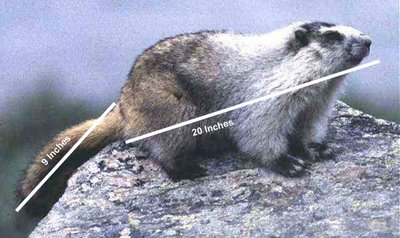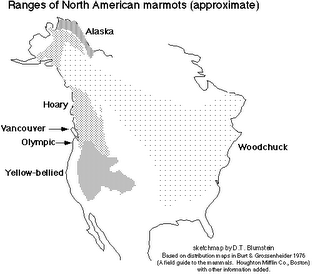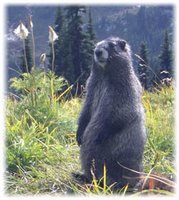Thursday, November 24, 2011
A Yellow Bellied Marmot on the loose in the city of West Vancouver, Canada??
Indeed. Here is the story of Mortimer: http://www.nsnews.com/story.html?id=5024791
Thursday, July 13, 2006
A marmot's burrow
Marmots dig burrows for hibernation and to keep their offspring and themselves safe from predators. Marmots are very adept at digging and have the large, thick front claws to prove it. Marmots use the burrow to raise their young, which are born around mid-June. Usually 2 to 5 marmot pups are born in each litter. After about one month, marmot pups have all of their fur and can venture out of the burrow.
It has been suggested by researchers such as Art Kruckeberg that marmot burrows are play a part in shaping the ecosystem of some high mountain meadows. The meadows exist because there are no trees in the area and that allows for meadow vegetation to thrive. However, trees can eventually take over a meadow area and turn it into forest.
Marmots play a role in assisting trees in taking over meadow areas. When a burrow is dug, the result is a pile of fresh soil at the entrance to the burrow. It has been suggested that this fresh soil provides a nice area for tree seedlings to emerge. Once those seedlings grow up, they drop cones and more trees are born. Eventually, the pockets of trees converge to create a forested area. However, this takes substantial hundreds or thousands of years. A fire can easily claim the forest and turn it back into a meadow where the whole process can start again.
It has been suggested by researchers such as Art Kruckeberg that marmot burrows are play a part in shaping the ecosystem of some high mountain meadows. The meadows exist because there are no trees in the area and that allows for meadow vegetation to thrive. However, trees can eventually take over a meadow area and turn it into forest.
Marmots play a role in assisting trees in taking over meadow areas. When a burrow is dug, the result is a pile of fresh soil at the entrance to the burrow. It has been suggested that this fresh soil provides a nice area for tree seedlings to emerge. Once those seedlings grow up, they drop cones and more trees are born. Eventually, the pockets of trees converge to create a forested area. However, this takes substantial hundreds or thousands of years. A fire can easily claim the forest and turn it back into a meadow where the whole process can start again.
Hoary marmot behavior
Hoary marmots, unlike most other marmots, have a very loose social system. Some groups display a dominance hierarchy as such:
Adult males > adult females > 2 yr olds > yearlings > 1st year marmots.
I found it interesting that where there is plentiful food, hoary marmots will live in colonies. However, where there is not much food, colonies do not exist. When hoary marmots live in colonies males will mate with multiple females and fight with other males for dominance. However when hoary marmots do not live in colonies they will only mate with one female and there is limited conflict between males.
Adult males > adult females > 2 yr olds > yearlings > 1st year marmots.
I found it interesting that where there is plentiful food, hoary marmots will live in colonies. However, where there is not much food, colonies do not exist. When hoary marmots live in colonies males will mate with multiple females and fight with other males for dominance. However when hoary marmots do not live in colonies they will only mate with one female and there is limited conflict between males.
How big is a marmot?
 I've seen some pretty big marmots, usually not any longer than 20 inches, but much fatter than the one pictured here. Of course, I've also encountered smaller, more slender marmots.
I've seen some pretty big marmots, usually not any longer than 20 inches, but much fatter than the one pictured here. Of course, I've also encountered smaller, more slender marmots.If you want to see really fat marmots, go out hiking up in the high elevation meadows of the Cascades in mid September. This is right before marmots climb in their burrows to hibernate, so they are spending alot of time eating and getting fat. I've also noticed that marmots seem to be more accepting or ignorant of human presence during this time of year.
Marmots as pets
If you want an Olympic marmot as a pet, check out this website for some guidelines:
Some people have taken in orphaned marmots to care for until they can survive on their own in the wild. Of course many of these people probably end up keeping the marmot around as a pet afterwards. Some more interesting reading about Yellow-bellied marmots as pets can be found here.
I think a couple important considerations are to keep your marmot away from your garden, prepare yourself for burrows to appear in your back yard and don't be surprised when your marmot goes into hibernation!
Some people have taken in orphaned marmots to care for until they can survive on their own in the wild. Of course many of these people probably end up keeping the marmot around as a pet afterwards. Some more interesting reading about Yellow-bellied marmots as pets can be found here.
I think a couple important considerations are to keep your marmot away from your garden, prepare yourself for burrows to appear in your back yard and don't be surprised when your marmot goes into hibernation!
Thursday, July 06, 2006
Marmots of the World
I wanted to share some information about marmots all over the world. Interestingly, Marmots live only in the Northern Hemisphere, but can be found in North American as well as Asia and Europe.
Check out this Marmots of the World website for more details about all 14 species of Marmot. Something I found most interesting were the maps that show where the different species live.

Check out this Marmots of the World website for more details about all 14 species of Marmot. Something I found most interesting were the maps that show where the different species live.

An Introduction to Olympic Marmots
 Although Olympic Marmots live in Washington State, I do not recall any personal experience with the animals. I have not spent as much time in the Olympic Mountains as I have in the Cascades, and have not visited the appropriate habitats.
Although Olympic Marmots live in Washington State, I do not recall any personal experience with the animals. I have not spent as much time in the Olympic Mountains as I have in the Cascades, and have not visited the appropriate habitats.Here is a map of the Olympic Marmot habitat range in Washington State. The range of Olympic Marmots is much smaller than Hoary Marmots in Washington State alone. Once again, here is the map of the Hoary Marmot habitat range in Washington State.
An Introduction to Hoary Marmots
 Hoary Marmots are a species of Marmot that I have personal experience with. I've encountered these animals in the Washington Cascades, and the Garibaldi Ranges in Southwestern British Columbia.
Hoary Marmots are a species of Marmot that I have personal experience with. I've encountered these animals in the Washington Cascades, and the Garibaldi Ranges in Southwestern British Columbia.The entire range of Hoary Marmots, however, includes Alberta, British Columbia, Northwest Territories and Yukon provences in Canada. In the United States Hoary marmots can be found in Alaska, Idaho, Montana and of course Washington.
Hoary Marmots share the genus Marmota with other animals such as groundhogs and are closely related to prairie dogs. Hoary Marmots enjoy a habitat high in the mountains above the treeline. The snow sticks around so long in these areas that the Marmots' food sources are all buried for most of the year. Consequently, Marmots must hibernate for 7 to 8 months out of the year.
Marmots in Washington State
If you're looking for Marmots in Washington State, one place you can find them is the Cascades Mountains. Here is a map showing the habitat range of Hoary Marmots in Washington State.
Hoary Marmots (Marmota caligata) live in the Cascade Mountains, a range that runs north to south through the state, separating the wet, greener, western side of the state from the drier, arid, eastern side. The Cascade Mountains could easily be the subject of many blogs. Check out my website full of my photos from the Cascades.
Olympic Marmots (Marmota olympus) live in the Olympic Mountains, a range of mountains in the western-most portion of Washington State, the Olympic Peninsula.
Hoary Marmots (Marmota caligata) live in the Cascade Mountains, a range that runs north to south through the state, separating the wet, greener, western side of the state from the drier, arid, eastern side. The Cascade Mountains could easily be the subject of many blogs. Check out my website full of my photos from the Cascades.
Olympic Marmots (Marmota olympus) live in the Olympic Mountains, a range of mountains in the western-most portion of Washington State, the Olympic Peninsula.
Tuesday, June 27, 2006
Welcome
 So, I am a fan of marmots. The marmots that I'm talking about and have personal experience with are called Hoary Marmots. You can see a photo of one such marmot that I took while hiking in the Cascade Mountains about 2 years ago. You can see a larger version of the marmot photo here.
So, I am a fan of marmots. The marmots that I'm talking about and have personal experience with are called Hoary Marmots. You can see a photo of one such marmot that I took while hiking in the Cascade Mountains about 2 years ago. You can see a larger version of the marmot photo here.You may ask, Dave, why are you a fan of marmots? It's the way they whistle, I tell you!
